10 Types Of Ear Piercings To Try, Plus Pain Level & Healing Times For Each
Before electing for a new ear piercing, it's important to do your research. As fun and glam as it is to adorn your ears with gemstones, it's typically not the type of venture you turn to on a whim. Well, we take that back: If you're here reading this article, we'll assume you're not necessarily one to opt for an impulse pierce.
In fact, it's quite helpful to peruse all your options before adding to your ear party, both for you and your piercer.
Arriving at an appointment informed and prepared (bonus points for reference images) can help the process run more smoothly—meaning, more time picking out jewelry and less time settling on a location.
So go ahead and familiarize yourself with the 10 types of ear piercings below: We've made the decision easy for you, with pain levels and healing times for each.
Types of ear piercings
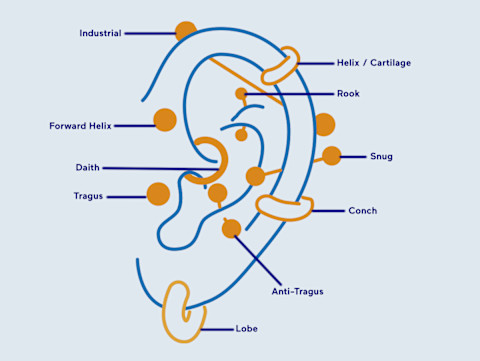
Here, we've ranked the 10 most common types of ear piercings based on average healing time and discomfort level. Just remember: Pain is subjective, so keep in mind that these averages are based on what professionals have seen with their clients—but you may experience more or less discomfort based on your own tolerance, piercer, piercing method, etc.
Lobe
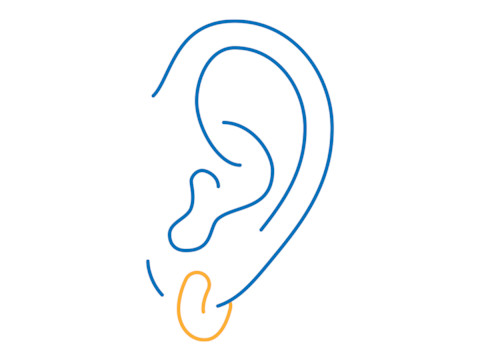
- Discomfort level: minimal
- Average healing time: 6 weeks
A lobe piercing is placed, well, on the lobe.
"This is generally a person's first ear piercing location," says registered nurse Samantha Alvarado, R.N., head of nurse training at Rowan, as the tissue is soft and heals rather quickly (around six weeks). "Although something should remain in the hole at all times for at least a year to keep the hole patent," she notes.
Meaning: You can change earrings after the six-week mark, but you might not want to leave it bare for too long.
Conch
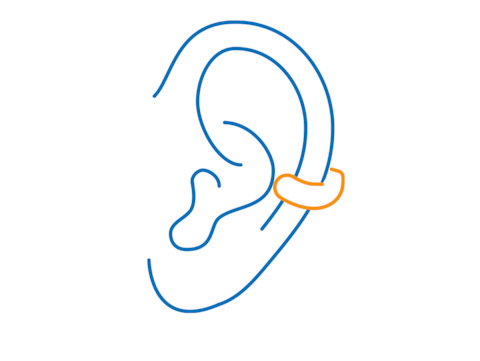
- Discomfort level: minimal
- Average healing time: 6 months
This piercing lands in the center part of the conchal bowl (hence its name) and is typically forward-facing.
"This allows for it to be well presented to anyone looking directly at you (like when you're engaged in conversation), but it's also easily concealable by your hair, if needed," says Johnny Pearce, professional piercer at Nine Moons Piercing.
This forward-facing nature also means it won't be as irritated when you sleep on your side (unless you have a hoop, like the graphic above), which makes it "arguably the easiest to heal of all the cartilage piercings," he says.
Helix / cartilage
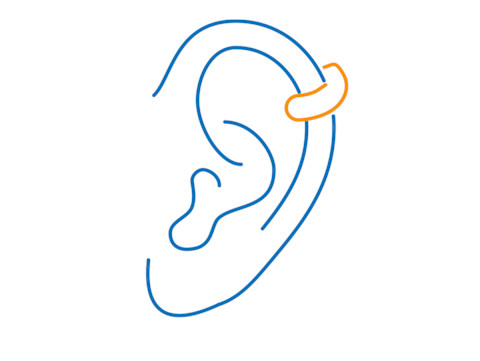
- Discomfort level: minimal
- Average healing time: 6 to 9 months
"A helix piercing, also known as the traditional cartilage piercing, falls anywhere along the outer rim on your ear, stretching from the upper earlobe until the forward helix area," says Pearce. "They are most often pierced and healed with a stud and can later be changed to a ring."
Because everyone's cartilage is unique (and your sleeping position can agitate the wound), healing time can vary quite a bit—Alvarado says you can change your earring as early as 12 weeks, unless the ear still feels tender.
Most should be healed by nine months.
Tragus
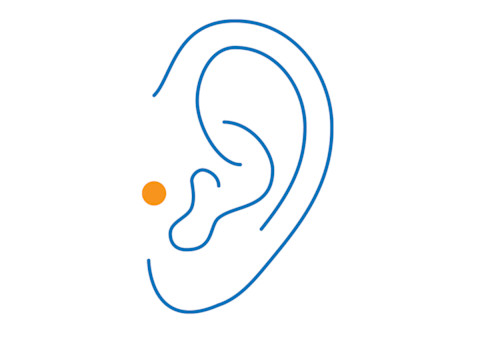
- Discomfort level: minimal
- Average healing time: 6 months
According to Pearce, a tragus piercing (pronounced tray-gus) resides on the dense part of cartilage in front of the ear canal—in layman's terms, it's the cartilage attached to the side of your face.
"Despite its density, the tragus piercing isn't all that painful to receive," he adds. "Most people report the briefest pinch, oftentimes followed by pressure that masks any further discomfort."
But here's the thing about tragus piercings: You'll want to avoid earbuds (like headphones) during the healing process.
"The continuous pressure can result in irritation and possibly cause the piercing to shift," says Pearce. "Not to mention, the exposure to bacteria can present a real risk for infections."
Stick to over-the-ear until the piercing is fully healed.
Forward helix
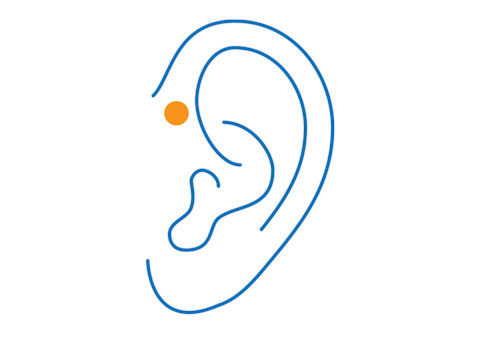
- Discomfort level: minimal to moderate
- Average healing time: 6 to 9 months
This piercing is on the same piece of cartilage as the regular helix—it just lands on the upper, foremost part of your ear.
"Oftentimes they are requested in pairs or even trios," says Pearce. (Note: Multiple piercings may require an extended healing time, so keep that in mind before you commit.)
"Hair, glasses, and mask loops tend to be the most common enemies for this piercing," he adds. "It can be helpful to bring your glasses with you to your appointment, so your piercer can make sure the piercing placement won't interfere with where your glasses lay."
Rook
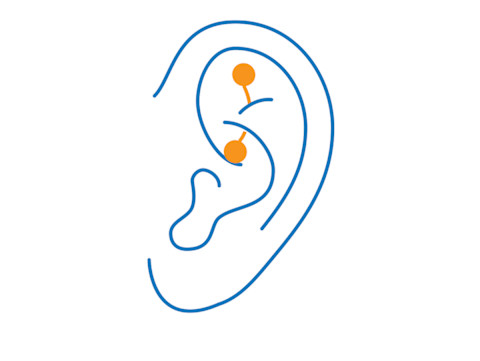
- Discomfort level: moderate to intense
- Average healing time: 9 to 12 months
An inner-ear piercing, the rook refers to that dense fold of cartilage on the upper part of the ear, intersecting perpendicularly with the forward helix.
"It's traditionally pierced downward, using a curved barbell so that the top gem sits flush and the lower part of the curve hangs beneath the rook, with the lower gem suspended in midair," says Pearce.
In terms of healing, it's tough: Pearce says it can take up to a year, if not longer, to completely heal. If you can, avoid sleeping on the piercing—it can get irritated and sore easily.
Daith
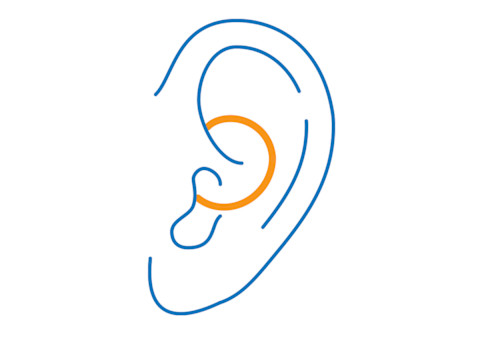
- Discomfort level: moderate to intense
- Average healing time: 6 to 12 months
Daith piercings are one of the few you can initially puncture with a ring instead of a stud. It's located between the tragus and lower part of the forward helix in the innermost part of your ear (a pressure point some claim can help with migraines), which keeps it protected from irritation during sleep.
However, "Don't be alarmed if you see an irritation bump beginning to develop," says Pearce. "Just take it as a sign that your piercing is grumpy and start thinking of ways that you can further minimize impact."
And like tragus, earbuds are a major no during healing.
Anti-tragus
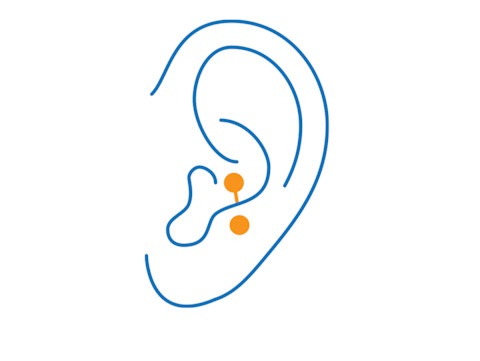
- Discomfort level: moderate
- Average healing time: 12+ months
Says Pearce, "This is a dense piece of cartilage that protrudes from above your earlobe. It usually sits across the bowl of the ear, adjacent to the tragus."
While studs are typically easier to heal, you can use a ring for the initial puncture.
"Expect for it to be more swollen and sore than other piercings you may have received," Pearce adds. "Avoid sleeping on it, as it will only prolong the soreness and exacerbate the swelling."
Depending on the exact placement, you may be able to get away with earbuds during healing—but it's best to ask your piercer for specific intel.
Industrial
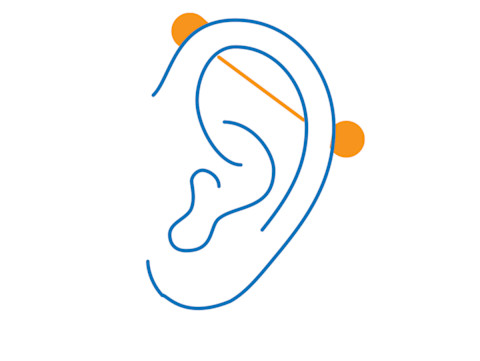
- Discomfort level: moderate
- Average healing time: 12+ months
An industrial piercing has two hyper-specific punctures—one on each side of the helix—connected by one long piece of jewelry.
"They both must be executed exactly as intended for this piercing to have a chance of healing successfully and comfortably for the client," says Pearce.
Read: You have to be super, super precise about placement, or the bar can lie at a wonky angle. This piercing can also get really irritated and swollen with agitation, so avoid sleeping on it at all costs.
Snug
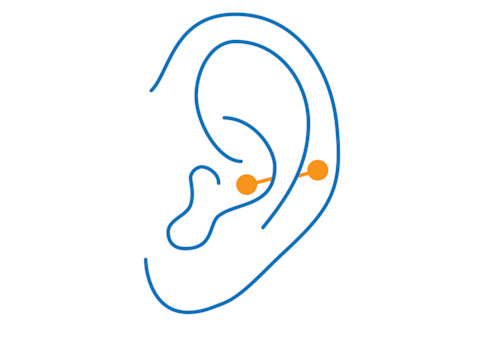
- Discomfort level: moderate to intense
- Average healing time: 12 to 18+ months
The snug is located at the outer rim of your ear, but it's pierced inward toward the conch. And according to Pearce, it's the most uncomfortable in terms of initial piercing and healing time.
"It responds to the slightest irritation with major redness and swelling, and it stays irritated and swollen much longer than other piercings do," he explains. "It may require several follow-ups and further jewelry changes to accommodate for swelling and in an effort to maintain comfort while healing."
In other words: This piercing is not for beginners, nor for the faint of heart.
General care tips
Pearce puts it perfectly: "Getting pierced is only the very first part of the battle. Now, you have to successfully heal it if you want any chance of keeping it long term." Each type of piercing has its own nuances to mind, but these are your general tips for aftercare:
Try not to agitate them
"Your primary job is to leave the piercing alone," says Pearce. "No touching, no twisting, no rotating, and nothing applied to the piercing site (other than sterile saline). When it comes to healing piercings, less is more."
Try not to sleep on the piercing until it's fully healed if you can, as the pressure can irritate the wound further (aside from conch piercings, which are protected inside the conchal bowl).
Keep the piercings clean
Aftercare may vary depending on your piercer, but most professionals will supply you with sterile saline to spritz on the piercing site each day. Other than that, a rinse in the shower will suffice—again, don't try to wiggle a cotton swab or ointment in there to clean the site.
And let's not forget: "Masks, headphones, and glasses all harbor bacteria and sit on or in your ears," says Alvarado. "We recommend you clean all of these things at least once daily with an alcohol pad to prevent introducing the bacteria to the site of your new piercing."
Once you do change your earrings, it's important to regularly clean those as well.
Optimize your body's natural healing abilities
People often forget that a piercing is, at its core, a puncture wound. Sure, it's a tiny one, but it's still classified as an injury; that said, both Pearce and Alvarado recommend getting plenty of rest, optimal hydration, and a well-balanced diet to help enhance your body's natural healing abilities.
To that end: "If you are feeling ill, please hold off on getting your new piercing, as it will affect your healing time," says Alvarado.
Know that everyone heals at different rates
It's important to manage your expectations with aftercare. Even two people with the same exact piercing can heal at totally different rates, depending on their anatomy and piercer.
"Some people can heal in six months, while others may take closer to a year," says Pearce. "So don't stress if you're at seven months and still don't feel completely healed."
We repeat: Everyone's body is different.
How to clean an ear piercing
Proper piercing care is essential if you’re getting a new stud. New piercings are wounds after all, so you’ll want to care for it with the utmost diligence. But as Pearce notes above, it’s equally important not to overdo it.
- Wash or sanitize your hands before handling your ears. It’s always important to handle the area with freshly cleaned hands, and be sure to avoid touching it between washes.
- Apply your saline solution. Most pros will give you a saline solution, but if not you can DIY it — see the recipe below. The best options are spray bottles, as you can douse the area without touching it too much. But if you need to use a cotton ball, please just gently press it on the piercing—don’t rub or scrub.
- Don’t forget to treat the front and back of the piercing with the saline solution.
- While wet, some pros will advise you to rotate it. But this will depend on the piercing itself. If you’re not sure, ask the piercer.
- Let the solution dry, and refrain from touching it again until the next session. It’s recommended to do this once or twice a day.
- Other than that, water from the shower will also help keep it clean. But avoid getting shampoos and other cleansers in the area, as they may be too irritating.
DIY saline solution:
- Mix 4 cups of warm water with 2 teaspoons of table salt.
- Mix the solution, then let it cool before using.
- Store it in a fridge for up to one month.
FAQ
What's the most painful piercing?
For the ear, the daith, rook, and snug are most intense. In addition, the snug piercing can be challenging to care for and may experience painful tenderness for months after. For the rest of the body, genitals, nipple, nose, and dermal piercings are considered to be the most painful.
What to do in the case of an infection
An infected piercing will have yellow pus discharge, swelling, redness, and tenderness. In the case of an ear piercing infection, apply a warm compress to the area to help with swelling. Gently clean the area with the saline solution two to three times a day, but do not twist, pull, or remove the piercing. Do not use antibiotic ointments or alcohol as those will only irritate the area more. If symptoms progress over 3 days (and you experience pain or even a fever), visit a doctor.
When can I change my ear piercing?
Folks can change their ear piercing when the initial wound has healed, which is different lengths for each. For simple lobe piercings, that’s as little as 6 weeks. For daith, industrial, snug, or anti-tragus, it can be a full year, if not more. However, every body is different—so you should consult your piercer who will be able to tell you when you can safely change it.
The takeaway
Choosing a piercing isn't just about which jewels will look best on your ears (although, that is the fun part; see here for our favorite sustainable metals and stones). Discomfort level and healing time are important factors to keep in mind, as is your personal ear anatomy—some piercings just won't work on certain angles and folds.
